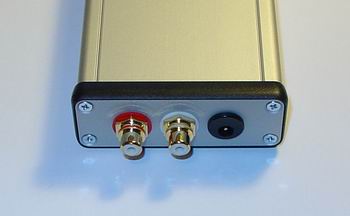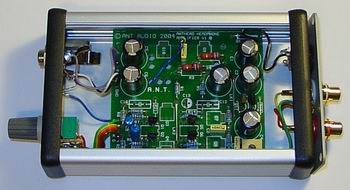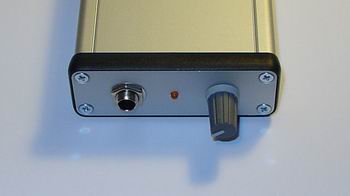"AMBER" - New HeadAmp from Alexey Nikitin (ex CREEK Audio)
Photo and review's fragments were taken from the http://www4.head-fi.org forum
FIRST IMPRESSIONS
EXTERNAL BUILD
First impressions of the ANT amp registered a big fat zero. It's a standard Hammond case, the likes of which I've been drilling and ruining for a couple of years now.
Admittedly it was the prototype that I was viewing, but slightly crooked RCA sockets, standard low cost instrument-type volume knob and just a total lack of any effort on the visual front did not
bode well. The power brick is: well, you get one. It's like anything supplied with anything DC-powered that you buy. It is not a fancy PSU. It is world voltage however, so it'll work anywhere. Alex
assures me that it tests better than most of this ilk.
 
 
The picture you're seeing is of the production PCB. All in all, it looks several hundred dollars cheaper than the US-based
competition: I won't bore you with the parts in use (take a look at the pictures for that), but it's well below the standards at first
glance than what's in use by the other amps, commercial or DIY at this price level. Where's the Blue Velvet / Noble? Where are
the Black Gates? The cost of the opamps is not an issue so where's that gone? If we're assuming Alex isn't overpricing the
amp, it tells you that a lot of the cost is in the labour that went into making each amp, as well as a serious investment in honing
this design that has to be recouped. As for the parts picks, Alex says that he tested a wide range of bits and he put the best that
he could find for the target price into the amp. He also stressed the amount of toil involved in matching the transistors and
opened up the prototype amp for me when we first met. From what he was aiming at in terms of the parts populating the board,
although I appreciated his stress on the intricacies of construction, I had to admit it looked like a CMOY-level project. I was not hugely impressed.
BUILD QUALITY
The internal build in general reflects the indifferent externals. It is acceptably executed in order for the amp to do it's job and tidy,
but lacks finesse and attention to detail. The build quality does not approach Ray Samuels layout and detailing, and nor does it
approach JMTAudio's superior standard of "DIY soldering". There is room for improvement in all of these aspects.
TECHNICAL DESCRIPTION
So, unimpressive parts and looks aside, what exactly have we got here as far as the layout of the ANT amp is concerned?
Some technical talk later and my hopes are up as some impressive specs were issuing forth from Alex. The ANT is not an
'opamp' based amplifier. Simply put, as far as the layout goes if you think about it like a solid-state tube amp, you're not far
wrong. The thing that he puts particular emphasis on is the extremely low distortion of the amp.
- Completely FET-based, discrete components only, very precisely hand-matched transistors
- Class A, Single-ended, Zero-Feedback
- One capacitor in the signal path (at the output)
- 15v 250ma power requirement
- Less than 5 ohms output impedance, no output resistors, 10K input impedance
- Panasonic FC caps
- S/N ratio of >96db, THD <0.3% mostly second order, 3rd order <0.03% (ref: 0.5V output into 100 ohm load)
- Frequency Response - 5hz ~ 50khz into 30 ohms
Interesting, and the numbers are good. But the proof is in the listening, so I fired it up
SONIC PERFORMANCE
RESOLUTION
Within a day of listening, I'd kind of got past the looks of the amp. Within two weeks, I'd totally got past it. Of note is a
concentration upon detail, and I had to conclude by the end of evaluation that although it's not the best I've heard, this ranks as
one of the most effortlessly detailed performances I've had out of the HD650. Pedantic levels of 'detail etching' are avoided, and
instead the amp maximises the ability of phones to resolve in an unobstrusive way. Not much else to say to pad out this section:
The ANT is certainly not holding the Sennheiser back. If anything, the HD650 is holding back the ANT.
DYNAMICS
Very good: in fact, excellent. The ANT addresses practically all dynamic requirements that's made of a quality amp in a
convincing manner. Given large changes in overall volume in a short space of time (sudden orchestral build-ups are a good
example), the circuitry seems to have enough reserve grunt to deliver whatever is required. When urgency and ultra-snappy
transients are required, the ANT rises to the challenge. On spinning more metal and electronica elements of my listening, the
ANT grabbed the HD650 by the neck and headbutted it to wake it up. The bass drops had the initial focus and transition
nearing electrostatics but the decay and bloom of dynamics, voice transients were extremely focused without a loss of realism,
and the cymbals came across as, well, cymbals: an overall satisfying experience musically and from a technical audiophile point
of view. Yet while listening to delicately woven solo piano for example, the amp never stepped out of line by becoming 'stodgy'
or 'stompy', conveying the performance with appropriate lightness of touch. Once again, it's a notable performance from the ANT
TONALITY
The sound can be described as 'pure' but it's not what many would call 'neutral'. There's a certain amount of low-end bloom
(without flab) which reinforces the capabilities of somewhat pop-tuned all-rounders such as the HD650 and delivers a firmly
planted bass without resorting to gimmicks. Treble and midrange tonality resembles well-balanced amps such as the standard Ray Samuels XP-7, in that no particular elements of midrange or treble dominate.
IMAGING/STAGING
It's surprising how much imaging and staging can actually vary with amps. The ANT presented one of the wider examples of
staging I've heard, and enabled the layers of music to be clearly discerned as a whole, as well as easily being able to focus on individual instruments. No problems here.
OTHER CHARACTERISTICS
TUBEROLLING, OPAMP-ROLLING AND:
Transistor-rolling? Yes, it's remotely possible although it's not going to be a straightforward case of whacking in a few
transistors, due to the very careful matching required. I listened briefly to two versions of the amp on which Alex assured me that
only the transistors and the component group around it had been changed, and it did indeed sound subtly different. 'Voicing' the
amp therefore is a distinct possibility. However, I'd be the first to say that this method of rolling lacks the romance of swapping
tubes around, and it being somewhat technical in nature kind of kills the essentially non-technical fun of 'rolling'. Maybe Alex can do something about that.
HEATED CAPS
An interesting side-fact: The capacitors in this amp noticeably heat up. According to Alex, this is intentional and the
specification of the amp remains more constant in use, as well as improving the sonics compared to when used 'cold'.
NOMINAL PORTABILITY
The amp is small enough to be transportable, but as is, it is AC power dependent. Alex notes that the battery board of the PPA
project is compatible when set to deliver 12V, but with the current demands of the amp the battery life will probably be quite low.
HEADPHONE COMPATIBILITY
When used with lower impedance phones and a 'high-powered' source the volume must be adjusted during the initial few
millimetres of movement. The pot used in the prototype had some problems maintaining channel balance at these levels. An
alternative that Alex gave me to try did exhibit much better control of the channel balance on the initial throw, but exhibited some sonic deficiencies. This might need more work.
COLLECTED OPINIONS
Emphasising its comparatively simple layout, Alex Nikitin's ANT amp is definitely one of the better exponents of 'crap in, crap
out' precision delivery that I've heard. I use words like 'smooth' sometimes to be polite to amps which don't resolve. In this case,
no such euphemisms are required and yet the ANT does indeed sound 'smooth'... a nicely tempered tone which doesn't
unnecessarily accentuate areas of the midrange or the highs. If you own a capable high impedance headphone such as the
HD650, the ANT presents one of the (if not the) most compelling options for amplification at this price. The source-to-ear purity
level of the ANT is not something that you need to dwell on; it is more or less right in front of you straight after plugging in and
does not wait around to be discovered: all the more so the better your headphones are. HD650, DT880, CD3K, RS-1 and
ATH-W2002 owners will have good experiences with this amp. For the reasons stated previously I think Alex will have to make a
considerable effort to improve the currently extremely basic product presentation of the amp. This is likely to raise the price of
the amp though, so it is ultimately a matter of how much you, that is the potential buyer of the amp, needs that aspect
addressed. What about upgrades? Even the other 'colours', that is different grades of the amp are unlikely to sell for a fortune...
and there will be a lower-priced entry-level model, presumably at the uber-PIMETA pricing level. I think that in terms of the
design philosophy and in the intention to paint as clear a sonic picture as possible, the first ANT amp is a success. In many
ways the ANT is a stereotypical 'old-school' homegrown British product, albeit this time with a Russian flavour. It's low-rent,
seemingly low-tech nature hides a notable level of performance which seems impossible from first impressions. If you can get
past the looks and the build, the ANT 'Amber' is priced below what it's performance would generally dictate in terms of sonic
performance, even when compared to the better amps I've used. Definitely worth a try.
|

